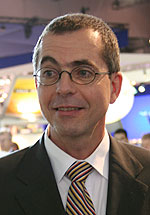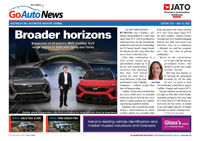News - Mercedes-Benz - C-ClassMercedes-Benz hits out at new P-plate banKompressed: The 1.8-litre supercharged engine in the new C-class is no fireball, but it is banned under new Victorian P-plate legislation. Benz boss hits out at laws that ban P-platers from driving the 1.8-litre C-class7 Aug 2007 THE managing director of the Mercedes Car Group in Australia has declared the German marque will fight any existing or proposed state laws that preclude P-platers from driving vehicles such as the least-powerful C-class models. Speaking at the launch of the new-generation C-class late last month, Horst von Sanden argued that new Victorian laws did not sufficiently distinguish between the many and varied types of turbocharged and supercharged vehicle applications. “We are very determined to go against that very aggressively,” Mr von Sanden told GoAuto. Under Victorian legislation that came into effect from July 1, 2007, the base C200 Kompressor is banned for new P-platers because it has a supercharged engine. This is despite the fact that it is a 1.8-litre four-cylinder unit that produces 135kW of power and 250Nm of torque, which is only 16kW and 24Nm more than a Subaru Liberty 2.5i, and 50kW and 86Nm below that of the Toyota Aurion’s 3.5-litre V6 outputs – both of which are not included on the list. The C200K comes within the guidelines that outlaw new drivers from that date from operating vehicles “with more than eight cylinders a turbocharged or supercharged engine (except diesel-powered vehicles) and an engine that has been modified to increase its performance.” The Victorian list includes other vehicles that are also subject to the ban these include BMW’s M cars, the BMW Z4, Nissan 350Z, Honda NSX, all post-1993 Porsche 911s, all post-1999 Porsche Boxsters, the Porsche Cayman, Mercedes SLK350, Mercedes C350 and Mercedes C36. Interestingly, Mercedes’ own Smart is exempt, despite having a turbocharged three-cylinder engine.  Left: Managing director of the Mercedes Car Group in Australia, Horst von Sanden. Left: Managing director of the Mercedes Car Group in Australia, Horst von Sanden.With the majority of C-class sales made up of the supercharged C180K and C200K models over the past five years, the P-plater ban could have sales consequences for Mercedes-Benz. It also means that children of parents or guardians who own these models might resort to purchasing another vehicle – and often this would mean a less-expensive, and much older and/or perhaps less safer, choice. “It is absolutely unacceptable what this regulation does: it takes the safest car away from those kids who need safe cars most,” Mr von Sanden said. The Mercedes-Benz boss would like to see its C180K and C200K models exempt from the Victorian ban immediately, just as they are now off the NSW hit-list. Initially, the company’s pleas with the NSW Government to allow the supercharged four-cylinder C-class range to be granted an exception was ignored following the 2004 implementation of the ban. Mr von Sanden said he had to intervene personally: “Their reaction (in the first instance) was very hostile (saying) ‘that’s the way it is’ (until) I got involved.” He said it was only after a series of discussions before Mercedes finally had its way. The new Victorian laws do not just apply to Mercedes. There is an increasing number of car-makers using turbocharged and supercharged technology on smaller engines to reduce emissions and avoid punitive taxes. Models using Volkswagen’s new 1.4-litre turbo/supercharged TSI unit – with power and torque outputs broadly equating to the company’s outgoing 2.0-litre FSI four-cylinder petrol engine – face the P-plater ban, for instance. Mr von Sanden said he understood that the legislation was there to protect inexperienced drivers from getting behind the wheel of powerful vehicles and doing themselves and others harm. “What (we) want to avoid is kids in cars such as WRXs that have incredible performance and are like weapons on the road,” he said. “I know what they want to achieve – the Victorian Government – and I support that wholeheartedly. “But how they are trying to achieve it is absolutely wrong.” Mr von Sanden believes part of the answer lies with driver education. “In Germany... it is very, very expensive for the consumer to get a driver’s licence,” he said, adding that it can cost upwards of 3000 Euros (in excess of $A5000). “You must sign up with a professional driving school, you have to go through all the different (training regimes)... and only after the driving instructor gets the impression that the learner is ready then will he proceed with the actual test.” Mr von Sanden said he supported Germany’s method of driver education because it is of “a different quality” to the way Australian drivers are educated. However, he also acknowledged that there are social, political and financial hurdles that must be cleared before better education can become available in Australia. “Maybe the infrastructure is different to Germany and maybe many people cannot afford to get money together to get a driver’s licence, but then maybe the government could subsidise that,” he said. Mr von Sanden suggested that some of the budget governments in Australia allocate towards road trauma and speed-reduction campaigns could be channelled into better education and training. “(Already) they’re spending millions and millions on road safety campaigns,” Mr von Sanden said. The issue of restricting P-platers and achieving greater road safety through improved education and training is a personal one for Mr von Sanden. “I’ve got a son myself who just started driving four weeks ago, and I think you could wish for nothing better than to have (your child) in a C-class or something comparable,” he said. Read more:First drive: Mercedes strikes a C sharpRead GoAuto's drive impressions of the new Mercedes-Benz C-class range First look: Benz spoils M3 party with C63 AMG |
Click to shareMercedes-Benz articlesResearch Mercedes-Benz C-Class pricing
Motor industry news |














Facebook Twitter Instagram